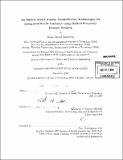An optical smart needle : point-of-care technologies for integrated needle guidance using optical frequency domain ranging
Author(s)
Goldberg, Brian, 1979-
DownloadFull printable version (13.11Mb)
Alternative title
Point-of-care technologies for integrated needle guidance using optical frequency domain ranging
Other Contributors
Harvard University--MIT Division of Health Sciences and Technology.
Advisor
Guillermo J. Tearney.
Terms of use
Metadata
Show full item recordAbstract
Obtaining accurate needle placement is of critical importance in many medical scenarios. In the setting of fine needle aspiration biopsy (FNAB), manual palpation is often the only cue for determining the optimal position of the needle. As a result, FNAB procedures frequently yield non-diagnostic tissue. When not guided by an imaging modality, breast and thyroid FNAB's only obtain diagnostic tissue in approximately 65% of cases. Although the addition of noninvasive imaging technology has been shown to increase FNAB yield, it is time-consuming, relatively expensive, and often requires additional personnel with specialized expertise. A need exists for low-cost, small, simple to use technologies that can provide active feedback during needle placement. One promising method for guiding needle placement would be to integrate an optical sensor that could identify tissue type at the tip of the needle in order to avoid non]diagnostic sampling. Optical technologies are well suited to this challenge because sensors can be made using optical fiber which is as thin a human hair. Optical frequency domain ranging (OFDR) is an optical ranging technique that is capable of measuring depth-resolved (axial, z) tissue structure, birefringence, flow (Doppler shift), and spectra at a micrometer level resolution. Analysis of the OFDR depth reflectivity profiles yields information about the nature of the tissue being interrogated at the tip of the probe and algorithms can be developed to automatically differentiate between tissue types. The overall goal of this thesis is to develop a small, portable, point-of-care optical system that can be used to differentiate human breast tissue and guide needle placement in the setting of FNAB. We will investigate enabling technologies that allow for efficient simplification and miniaturization of an OFDR system including signal processing algorithms for automatically differentiating tissue type, a miniature battery-powered laser, and a study of the effect of reduced-bit depth acquisition for OFDR systems. Throughout, we will focus on trade offs between size and performance while taking into account usability, robustness, and overall cost which are key features of point-of-care technologies.
Description
Thesis (Ph. D.)--Harvard-MIT Division of Health Sciences and Technology, 2009. Cataloged from PDF version of thesis. Includes bibliographical references (p. 107-112).
Date issued
2009Department
Harvard University--MIT Division of Health Sciences and TechnologyPublisher
Massachusetts Institute of Technology
Keywords
Harvard University--MIT Division of Health Sciences and Technology.